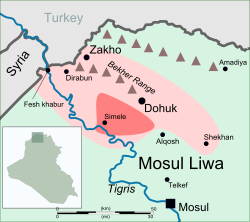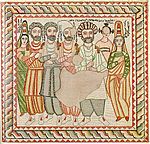Simele massacre
| Simele massacre | |
|---|---|

Area where villages were looted
Heavily targeted Assyrian villages
|
|
| Location | North of the Kingdom of Iraq, notably at Simele |
| Coordinates | 36°51′30″N 42°51′00″E / 36.858334°N 42.850099°ECoordinates: 36°51′30″N 42°51′00″E / 36.858334°N 42.850099°E |
| Date | 7 August 1933 – 11 August 1933 |
|
Attack type
|
Summary executions, mass murder, looting |
| Deaths | 5,000–6,000 |
| Victim | Assyrians |
History of the Assyrian people
Old Assyrian Empire (20th–15th c. BCE)
Neo-Assyrian Empire (911–612 BCE)
Achaemenid Assyria (539–330 BCE)
Seleucid Empire (312–63 BCE)
Parthian Empire (247 BCE – 224 CE)
Osroene (132 BCE – 244 CE)
Syrian Wars (66 BCE – 217 CE)
Roman Syria (64 BCE – 637 CE)
Adiabene (15–116)
Roman Assyria (116–118)
Christianization (1st to 3rd c.)
Nestorian Schism (5th c.)
Asōristān (226–651)
Byzantine–Sasanian wars (502–628)
Muslim conquest of Persia (630s-640s)
Abbasid Caliphate (750–1258)
Emirs of Mosul (905–1383)
Buyid amirate (945–1055)
Principality of Antioch (1098–1268)
Ilkhanate (1258–1335)
Jalairid Sultanate (1335–1432)
Kara Koyunlu (1375–1468)
Ağ Qoyunlu (1453–1501)
Safavid dynasty (1508-1555)
Ottoman Empire (1555–1917)
Schism of 1552 (16th c.)
Massacres of Badr Khan (1840s)
Massacres of Diyarbakir (1895)
Rise of nationalism (19th c.)
Adana massacre (1909)
Assyrian genocide (1914–1920)
Assyrian independence movement (since 1919)
Simele massacre (1933)
Post-Saddam Iraq (since 2003)
...
Wikipedia

